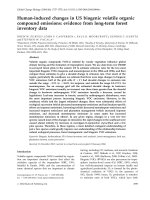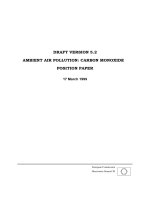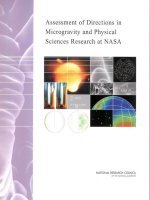- Trang chủ >>
- Khoa Học Tự Nhiên >>
- Vật lý
5 2 changes in matter (physical sciences)
Bạn đang xem bản rút gọn của tài liệu. Xem và tải ngay bản đầy đủ của tài liệu tại đây (5.54 MB, 12 trang )
Physical Sciences
Standards
Preview
1.f. Students know differences in
chemical and physical properties
of substances are used to separate
mixtures and identify compounds.
Standard Set 1. Physical Sciences
1. Elements and their combinations
account for all the varied types of
matter in the world. As a basis for
understanding this concept:
1.g. Students know properties of solid,
liquid, and gaseous substances, such
as sugar (C6H12O6), water (H2O), helium
(He), oxygen (O2), nitrogen (N2), and
carbon dioxide (CO2).
1.a. Students know that during
chemical reactions the atoms in the
reactants rearrange to form products
with different properties.
1.c. Students know metals have
properties in common, such as high
electrical and thermal conductivity.
Some metals, such as aluminum (Al),
iron (Fe), nickel (Ni), copper (Cu),
silver (Ag), and gold (Au), are pure
elements; others, such as steel and
brass, are composed of a combination
of elemental metals.
Genre
Nonfiction
by Marcia K. Miller
Comprehension Skill
Draw Conclusions
Text Features
•
•
•
•
Captions
Charts
Labels
Glossary
Science Content
Changes in Matter
Scott Foresman Science 5.2
ISBN 0-328-23566-0
ì<(sk$m)=cdfg h< +^-Ä-U-Ä-U
Vocabulary
chemical change
chemical equation
condensation
evaporation
physical change
product
reactant
sublimation
by Marcia K. Miller
Picture Credits
Illustrations
12 Patrick Gnan.
Photographs
Every effort has been made to secure permission and provide appropriate credit for photographic material. The
publisher deeply regrets any omission and pledges to correct errors called to its attention in subsequent editions.
Unless otherwise acknowledged, all photographs are the copyright of Dorling Kindersley, a division of Pearson.
Photo locators denoted as follows: Top (T), Center (C), Bottom (B), Left (L), Right (R), Background (Bkgd).
4 (L) ©Richard Megna/Fundamental Photographs; 9 (TL) ©Floyd Dean/Getty Images; 10 (BR) ©Paul Seheult; Eye
Ubiquitous/Corbis, (L) Getty Images; 13 (TL) ©Richard Megna/Fundamental Photographs; 16 (B) ©Julian Calder/Corbis;
17 (L) ©Richard Megna/Fundamental Photographs; 19 (BL) ©Clive Streeter/DK Images.
ISBN: 0-328-23566-0
Copyright © Pearson Education, Inc. All Rights Reserved. Printed in the United States of America.
This publication is protected by Copyright, and permission should be obtained from the publisher prior to any
prohibited reproduction, storage in a retrieval system, or transmission in any form by any means, electronic,
mechanical, photocopying, recording, or likewise. For information regarding permission(s), write to
Permissions Department, Scott Foresman, 1900 East Lake Avenue, Glenview, Illinois 60025.
1 2 3 4 5 6 7 8 9 10 V010 13 12 11 10 09 08 07 06
What are physical and
chemical changes?
Physical Changes
In a physical change, matter keeps the same
chemical properties. Physical changes include changes in
the size, shape, volume, and state of matter. Falling rain
may start as drops. The drops can freeze into hard sleet.
Raindrops and sleet have different sizes, shapes,
volumes, and states of matter. But both
are forms of water.
Tearing paper, sawing wood,
grating a potato, and melting wax
are all physical changes. Some
physical changes can surprise you.
Salt crystals seem to disappear in
water. But the salt is still there.
Salt crystals will appear again if
you let the water evaporate.
Chemical Changes
In a chemical change, one kind of matter changes
into a different kind of matter with different properties.
Cooking makes foods go through chemical changes. A
cooked potato doesn’t taste or smell like a raw one.
In a chemical change atoms rearrange themselves to
form other kinds of matter. It’s not always easy to know
when a chemical change occurs. You can learn some of
the clues to this kind of change. Chemical changes may
cause heat, light, or sound. Iron is usually gray. Rust is redorange. A color change is a hint of a chemical change. Rust
is a new material. It has different properties than iron.
Cooking causes chemical
changes in the potato.
Peeling and grating are two
kinds of physical changes.
2
3
Evidence of Chemical Changes
Chemical changes often produce a gas or a solid. The
pictures on page 5 show some of the steps in a chemical
change. Copper wires are twisted together into a tree shape.
The copper tree is then put into a chemical solution. A
chemical change makes solid crystals form on the tree.
Crystals cling to the wires. These solid crystals prove that a
chemical change took place.
Burning is another chemical
change. Look at the picture of
the candle. The candle and the
oxygen in the air both go through
this chemical change. The process
of burning creates three new
substances. They are ash, carbon
dioxide gas, and water vapor. All
of these substances have different
properties from the candle and the
oxygen.
When wax melts, it is a
physical change. When the
wax and wick burn, they go
through chemical changes.
4
This tree is made of copper
wires bent together.
The jar has a chemical
solution in it. The copper
tree is put into the
solution.
There has been a chemical
change. Solid crystals grew on
the copper tree. The crystals
were formed by a chemical
reaction. The liquid changed
from clear to blue.
5
How does matter
change state?
States of Matter: Solids
And Liquids
Water has three forms. Water is a
liquid in rivers and seas. It is a solid
when it is frozen as ice. It is a gas in the
air. These three forms are called phases or
states of matter. The phase of any material
is the result of the motions and positions of its
molecules or atoms. The state of a material at
room temperature is a physical property.
A solid has volume and shape. The particles
in most solids are very close together. They
vibrate in place. Forces between the particles keep
them from moving apart.
A solid melts into a liquid as it warms
up. The particles no longer vibrate in one
place. Forces between particles hold
them close together, but the particles
can move and flow. Liquids do not have
their own shape. They take the shape of
their container. Liquids have a definite
volume.
States of Matter: Gases
The particles of a gas are far apart, with more
space between them than between the particles of
a liquid or a solid. Gas particles can be squeezed
more than the particles of solids or liquids can be.
Gas particles generally do not affect one another
unless they hit each other. They spread out evenly
in a container. Therefore, a gas has no definite
shape or volume.
Solid
Liquid
Gas
6
7
Freezing and Melting
If a liquid gets cold enough, it may freeze. The liquid
turns into a solid. The frozen particles slow down. They
vibrate in place. There are two names for the point at which
matter changes from a solid to a liquid. The freezing point
is the temperature at which a liquid becomes a solid. The
melting point is the temperature at which a solid becomes a
liquid.
The melting point is a physical property of all matter.
You can use this property to help identify matter. A
melting point is the same for any amount of a material.
But the melting point may change if things are added to a
material. You can raise the melting point of ice by adding
salt to it. Saltwater freezes at a lower temperature than fresh
water does.
Particles in Motion
Materials change size as they change in temperature.
But no new material is made or destroyed. Particles always
move. They move faster as a material heats up. Fastmoving particles usually have more space between them.
The extra space lets the material get a bit larger. You can
see this in a thermometer. The liquid in the glass tube
expands as it warms up.
Materials may get a little smaller as they cool off. Cold
particles move more slowly. They have less space between
them. The particles can never get cold enough to stop
vibrating.
8
Material
Melting Temperature
Oxygen
–218°C
Nitrogen
–210°C
Mercury
–39°C
Fresh water
0°C
Sugar (Glucose)
146°C
Table sugar (Sucrose)
185°C
Aluminum
660°C
Gold
1063°C
Nickel
1453°C
Iron
1535°C
Tungsten
3410°C
9
Evaporation
Condensation
Evaporation takes place when particles leave a liquid
and become a gas. Speed helps the particles of a liquid
to evaporate. They must move upward fast enough to
overcome the forces at the surface.
Particles can evaporate everywhere in a liquid, not just
at the surface. This happens if the temperature of the liquid
is hot enough. As gas particles move up through a liquid,
gas bubbles form under the surface. The boiling point of
a liquid is the temperature at which the liquid turns into
these gas bubbles throughout the liquid.
The boiling point is a physical property. The boiling point
of a liquid is the same, no matter how much of it is heated.
You can use the boiling point to help identify a liquid.
Condensation takes place when a gas turns into a
liquid. This process often takes place when gas particles
touch a cold surface. This makes their temperature drop.
The particles slow down. They get trapped by the forces at
the surface. As more and more gas particles get trapped,
they form a liquid drop. Condensation forms the clouds in
the sky and the dew on the ground.
Water vapor is
invisible. When
you see steam,
you are seeing
tiny water drops
that form during
condensation.
Liquid can evaporate even if its temperature
does not reach the boiling point. This is what
makes your wet clothes get dry.
10
Sublimation
Sublimation takes place when some solids change
directly to gases without first turning into liquids. Carbon
dioxide is known as dry ice when it is in its solid form. Dry
ice can exist only when temperatures fall below -78.5°C.
At -78.5°C., the particles in dry ice begin moving very fast.
They escape from the solid as a gas. They skip the liquid
phase.
Material
Boiling Point
Helium
–268.9°C
Nitrogen
–195.8°C
Oxygen
–183°C
Chlorine
–34°C
Fresh water
100ºC
Mercury
357°C
Aluminum
2467°C
11
What are some kinds
of chemical reactions?
Magnesium and oxygen
are reactants. Bright
light and heat are
evidence of a reaction.
Chemical Equations
Substances change into other substances when there is a
chemical reaction. A substance used in the reaction is called
a reactant. A substance made by the reaction is called a
product. The atoms of reactants rearrange to form the new
products. The new products have different
Test tubes collect
properties than the reactants.
gas bubbles.
A chemical equation shows what
happens in a chemical reaction. The
reactants are on the left side. The products
are on the right side. Read the arrow
that goes from the reactants to the
products as “makes.” It’s like the
equal sign (=) in a math equation.
2H2O
2H2
+
O2
+
Water
Reactants
Hydrogen
Oxygen
Products
A battery
provides
the energy
for the
reaction.
12
Chemical Reactions
Magnesium is a silvery metal. It is often used in
fireworks. At a high temperature, magnesium reacts with
oxygen in the air. It burns with a bright white glow. This
chemical reaction forms a white powder. The powder, called
magnesium oxide, is the product of the reaction.
Matter Is Always Conserved
A chemical reaction cannot create or destroy matter.
This fact is called the Law of Conservation of Mass. It says
that the total mass of the reactants equals the total mass
of the products. Suppose you bake a cake. The mass of all
the ingredients equals the mass of the cake plus the mass of
the water vapor, carbon dioxide, and other trace gases that
float up from the oven. The trace gases give the cake its
great smell!
13
Types of Chemical Reactions
More Chemical Reactions
There are many kinds of chemical reactions. You
can use a model to make a chemical reaction easier to
understand. Of course a model isn’t the real thing. But
a good model can teach you about the real thing. Think
about trucks and trailers as models of atoms in different
kinds of reactions.
In a decomposition reaction, compounds split apart to
form smaller compounds or elements. Picture a truck being
unhitched from a trailer. The picture on page 12 shows this
kind of reaction. When water molecules break apart there
are two products: hydrogen and oxygen gases.
Elements or compounds can
come together to form new
compounds in a combination
reaction. Picture a truck
being attached to a trailer.
A combination reaction
takes place between iron and
sulfur. The two reactants produce a
compound called iron sulfide.
Another kind of chemical reaction is a replacement
reaction. One or more compounds split apart. The parts
then switch places. You can picture two trucks switching
trailers. A replacement reaction takes place when a candle
burns. Some candle waxes are long molecules of carbon
and hydrogen atoms. You have read that oxygen gas is a
molecule made of two oxygen atoms. When wax burns,
the long molecules and oxygen molecules break apart.
They rejoin to make new compounds that include
carbon dioxide and water.
After the reaction, a new
compound is formed. It is
not magnetic.
Before the reaction,
iron is a dark
magnetic material.
Sulfur is a yellow powder.
It is not magnetic.
14
15
Examples of Chemical Reactions
More Examples of Chemical Reactions
All chemical changes take place during chemical
reactions. In a chemical reaction, atoms in the reactants
reorganize into products that have different properties. No
atoms are lost. No new atoms are added. Atoms combine in
new ways to form a new substance.
Look at the chart. It shows how atoms rearrange in the
three types of chemical reactions you have read about. Rust
forms as a result of a combination reaction. Imagine that
the open circle in the chart is iron. The red circle is oxygen.
A new product forms from both kinds of circles when the
substances combine. The product is iron oxide, or rust.
Look at the photo of a chemical change. Two colorless
liquids were mixed together. One of the new products that
formed is the yellow substance you see. The other new
product dissolves in the water so you can’t see it. What type
of reaction has taken place?
As it turns out, this is a replacement reaction. Find the
model of the replacement reaction in the chart on
page 16. It shows that particles from the different
substances switch places in a replacement reaction. This is
how new substances can form.
Have you ever seen an adult put hydrogen peroxide
on a cut? Hydrogen peroxide is a clear liquid. It is made of
hydrogen and oxygen. It can break into water and oxygen
gas in a decomposition reaction. One substance breaks
apart to form new substances.
Rust forms on chains through a
combination reaction between
iron and oxygen.
Hydrogen peroxide is a
compound. Its chemical
name is H2O2.
Type of Reaction
Model
Decomposition
Combination
Replacement
16
Two colorless liquids were mixed. A
yellow substance formed. This shows
that a chemical change took place.
17
How are chemical
properties used?
Separating Mixtures
Chemical properties can separate some mixtures.
Scientists use chemical properties to separate fossils from
the rock that holds them. Fossils often form in limestone. It
is hard to remove limestone from a fossil without harming
it. Vinegar can break apart limestone. Fossils made of a
different rock do not react with the vinegar.
Separating Metals from Ores
Separating Solutions
Chemical properties can be used to separate elements
from solutions. When lead is mixed in a solution with
iodine and water, a change takes place. The lead reacts
with the iodine to form a yellow solid called lead iodide.
You can filter the lead iodide out of the liquid.
Identifying Substances
You can use chemical properties to identify acids and
bases. Lemon juice and vinegar are acids. Soaps contain
bases. Acids and bases react with chemicals in universal
indicator paper. The reactions make the paper change
color. Acids turn the paper red. Bases turn the paper purple.
Weaker acids or bases turn the paper other colors.
Ores are rocks full of metals and other substances.
People may use chemical properties to get the metals from
the ores. Iron ore has iron oxide. Heating iron ore in a hot
furnace with carbon separates the iron from the oxygen.
The products are pure iron and carbon dioxide.
Vinegar reacts with the
limestone, not the fossils.
Vinegar
18
Tap water
19
Glossary
What did you learn?
1. How do the particles differ in solids, liquids, and gases?
chemical change
a change in which one kind of
matter changes into a different kind
of matter with different properties
chemical equation
a statement of chemical symbols
that shows what happens during a
chemical reaction
condensation
the process by which particles leave
a gas and become a liquid
evaporation
the process by which particles leave
a liquid and become a gas
physical change
a change in which matter keeps the
same chemical properties; a change
in size, shape, volume, or state of
matter
product
a substance made by a chemical
reaction
reactant
a substance used in a chemical
reaction
sublimation
the process by which a solid
changes directly into a gas
20
2. Why do materials change size when they change temperature?
3. How are chemical changes related to chemical reactions?
4.
List and describe three ways that you have
used or benefited from chemistry today. After you have written
your list, go back and rework it so that it is in time order.
Rearrange words and sentences to make the piece clear and
interesting.
5.
Draw Conclusions You boil a raw egg for 10 minutes. You
remove the egg from the water, cool it off, and peel it. Did a
physical or chemical change take place? Explain.









